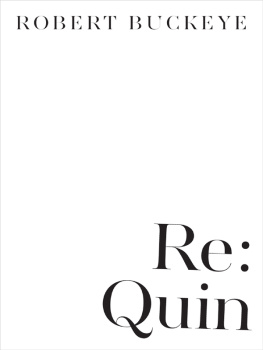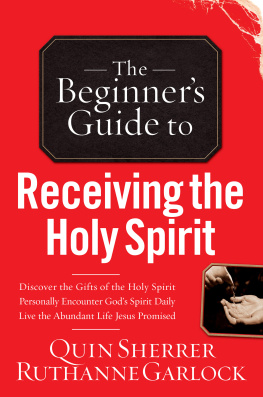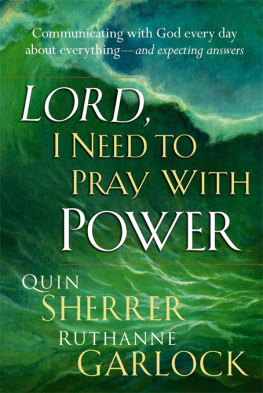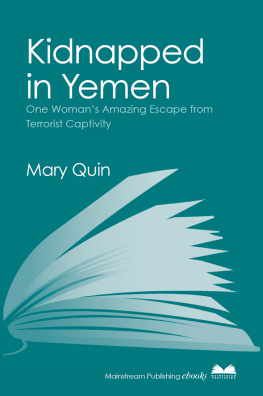Quin Ann - Re: Quin
Here you can read online Quin Ann - Re: Quin full text of the book (entire story) in english for free. Download pdf and epub, get meaning, cover and reviews about this ebook. City: Champaign;London, year: 2013, publisher: Columbia University Press;Dalkey Archive Press, genre: Art. Description of the work, (preface) as well as reviews are available. Best literature library LitArk.com created for fans of good reading and offers a wide selection of genres:
Romance novel
Science fiction
Adventure
Detective
Science
History
Home and family
Prose
Art
Politics
Computer
Non-fiction
Religion
Business
Children
Humor
Choose a favorite category and find really read worthwhile books. Enjoy immersion in the world of imagination, feel the emotions of the characters or learn something new for yourself, make an fascinating discovery.
- Book:Re: Quin
- Author:
- Publisher:Columbia University Press;Dalkey Archive Press
- Genre:
- Year:2013
- City:Champaign;London
- Rating:3 / 5
- Favourites:Add to favourites
- Your mark:
- 60
- 1
- 2
- 3
- 4
- 5
Re: Quin: summary, description and annotation
We offer to read an annotation, description, summary or preface (depends on what the author of the book "Re: Quin" wrote himself). If you haven't found the necessary information about the book — write in the comments, we will try to find it.
Re: Quin — read online for free the complete book (whole text) full work
Below is the text of the book, divided by pages. System saving the place of the last page read, allows you to conveniently read the book "Re: Quin" online for free, without having to search again every time where you left off. Put a bookmark, and you can go to the page where you finished reading at any time.
Font size:
Interval:
Bookmark:

SELECTED OTHER WORKS BY ROBERT BUCKEYE
Covering Ground
Pressure Drop
Setting a Table
The Munch Case
Still Lives
Re: Quin
Robert Buckeye

DALKEY ARCHIVE PRESS
CHAMPAIGN / LONDON / DUBLIN
Copyright 2013 by Robert Buckeye
First edition, 2013
All rights reserved
Buckeye, Robert.
Re: Quin / Robert Buckeye. -- First edition.
pages cm
Includes bibliographical references.
ISBN 978-1-56478-887-0 (pbk. : alk. paper)
ISBN 978-1-564-78989-1 (e-book)
1. Quin, Ann, 1936-1973--Criticism and interpretation. I. Title.
PR6067.U5Z55 2013
823.914--dc23
2013008513
Partially funded by a grant from the Illinois Arts Council, a state agency, and Middlebury College

www.dalkeyarchive.com
Cover: design and composition by Mikhail Iliatov
Printed on permanent/durable acid-free paper and bound in the United States of America
For Peter Anastas
TABLE OF CONTENTS
... how each of us manages to make more evident his own resistance. For that is the way a man comes to core. By way of, the discovery of, his own resistance.
Charles Olson
There was no beginning... Wed stopped living. The beginning did not, would not, exist prior to the end... Hallucinations within the hallucinations that was already speech. The body of a dead princess as a metaphor for literature.
Stewart Home
IN THE FALL of 1964, I heard Malcolm X speak at Wayne State University in Detroit. Several months before Congress passed the Tonkin Gulf Resolution and in Philadelphia, Mississippi, Andrew Goodman, Michael Schwerner and James Chaney had been murdered. The murder of John Fitzgerald Kennedy the year before had set off something, a premonition that was chilling, as if we had awakened to a world we did not believe, but no one, except perhaps Malcolm, anticipated what was to follow. Malcolm himself gunned down. Viola Liuzzo, a Detroit housewife, murdered by the Klu Klux Klan in Selma, Alabama. Martin Luther King shot. Robert Kennedy picked off. Riots in the cities, including Detroit three years later.
Malcolm was electric. Had there been anyone as charismatic, as challenging? Anyone whose mind as sharp as a knife? I still do not think so. Democracy had been a lie, Malcolm said, matter-of-factly, as if, of course, we all knew that, equality a myth, freedom for those with nothing left to lose. If we did not do something.
Malcolm paused, and the question hung in the air.
Well.
There was a storm coming.
What followed is by now an old story. For others, a story they dont want to hear. One that does not go away. Assassinations and turmoil worldwide. Protests against racial, gender and class inequality. Outrage against the Vietnam War (Vietnam, Vietnam, Vietnam, Michael Herr writes, weve all been there.) Rioting in Watts, Detroit, Newark, Chicago. Student protests in Warsaw, Mexico City, Paris, Berlin, across America after Kent State. Bloody Sunday in Derry, the Prague Spring, Solidarity, Che Guevara shot in Bolivia, Israels Six-Day War, a military takeover in Greece, Rudi Dutschke shot in Berlin. Its quasars were, J. G. Ballard was to tell us in Love & Napalm:Export U.S.A., Malcolm X, beautiful as the trembling hands in tabes dorsalis; Claude Eatherly, migrant angel of the Pre-Third; Lee Harvey Oswald, rider of the scorpion.
Things could not go on as they had before. The entire world was on the verge of radical transformation, Eliot Weinberger writes in Written Reaction, from the structure of society and state to the details of body ornament. The Stones and bellbottoms. Free love and free spirits. Equality as never before, possibility unthought of. Resistance and revolution. In the streets of Paris in May, 1968, French students took for their cry a Situationist International slogan, Under the Paving Stones, the Beach, to emphasize the need to discard the old ways of doing business to find a way to live that was free, fulfilling, just.
Some writers felt that their writing had not only to reflect the times, but also, in some way, lead them. The business of literature could not be conducted as it had been before. These writers dismissed traditional methods and ignored mainstream venues for new ways in which to write and alternative sites in which to situate their writingbars were not uncommon. Little mags far from New York, London or Paris proliferated. If it was poetry that brought the unsettled debts of history back into play, Greil Marcus writes in Lipstick Traces, the unsettled debts of history brought forth poetry. What they wrote, Weinberger adds, appeared, like oracles.
Ann Quins four novels bracket the Sixties. If establishment Anglo novels continued to dominate critical attention, there were writers like Quin whose books escaped, challenged or ignored tradition. Novels by Amis, Bellow, Davies, Fowles, Graham Greene, Mary McCarthy, Murdoch, Naipaul, Philip Roth, and Updike were contested formally from one side by John Berger, Gass, Hawkes, Aidan Higgins, Paul Metcalf, Pynchon and Wurlitzer, among others, and culturally from the other side by novels that resisted the imperatives of a middle class, increasingly petit bourgeois, reading public, including Burroughss Naked Lunch (1959), Trocchis Cains Book (1960), Lessingss The Golden Notebook (1962), Selbys Last Exit to Brooklyn (1964), J. J. Phillipss Mojo Hand (1966), Edith Templetons Gordon (1966), Sorrentinos The Sky Changes (1966), J. G. Ballards The Atrocity Exhibition (1969), Douglas Woolfs Spring of the Lamb (1972), any number of novels by B. S. Johnson.
For the most part these writers remain marginal, if not forgotten. Phillips disappeared. Woolf, a Harvard graduate, lived hand to mouth all his life and never drew the attention of the establishment. Trocchi withdrew into methadone treatment for drug addiction. Templetons Gordon is less than a trivia question. After a reading at a college, Metcalf, who is a grandson of Herman Melville, was asked by a professor where he got his doctorate. Of course, today, a Melville would be expected to find his Harvard at Harvard, not on a whaling ship. (In fact, Metcalf attended Harvard but left.) At the end of his life, Selby ended up in the classroom, where he joined Sorrentino and others in the great rush of the academy to find creative writers for its students who suddenly wanted to be writers.
If the times shaped Quin, she also played a part in their shaping. She is, moreover, a more radical writer than those I mentioned, most of whom retain traces of literature, however we understand them, that Quin discards or disdains. Only Burroughs, Metcalf and Woolf challenge literature in ways that she does. It is not that they teach us how to read them in reading them, but that our reading of them forces us to question the enterprise itself. In a footnote at the end of 69 Things to Do With a Dead Princess, Home contrasts Quin with Hemingway, Gertrude Stein and Beckett, noting, our attention could be more usefully directed towards Ann Quin. Her writing may yet survive its defeat, but its defeat surely determines literature in our times.
In a 1972 interview with John Hall in The Guardian, Quin says that one day her mother did not feel like reading to her and suggested the seven-year-old girl go into the garden and write a story of her own. Quin writes about a princess, prince and witch, dramatizing the triangulation of a relationship she would never resolve; the girl, as the woman, who would never know whether she would be a princess or witch; whether, in fact, one was also the other.
Next pageFont size:
Interval:
Bookmark:
Similar books «Re: Quin»
Look at similar books to Re: Quin. We have selected literature similar in name and meaning in the hope of providing readers with more options to find new, interesting, not yet read works.
Discussion, reviews of the book Re: Quin and just readers' own opinions. Leave your comments, write what you think about the work, its meaning or the main characters. Specify what exactly you liked and what you didn't like, and why you think so.










